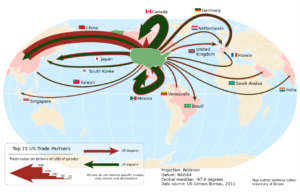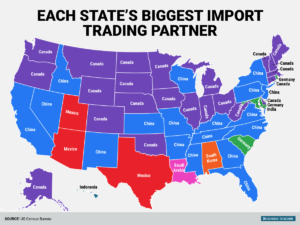What does foreign trade tell us about American politics? There’s an old adage; if you want to get to the root of a mystery follow the money. The saying takes on cynical connotations, particularly with respect to politics. To be fair I suspect it’s been at the heart of politics for generations. The Pharaohs of Egypt, the Caesars of Rome, and the emperors of China were all adept at trading money and power. More recently the adage has even crept into sports under the guise of analytics. While they retain their subjective talent evaluations, teams must be aware of a player’s cost/performance value. Even if they lack a formal ‘analytics’ process teams acquire, trade, and release players based on their costs. Players, agents, and fans all understand trades and releases are driven by more than just performance.
Outside of graft, corruption, and patronage – politely referred to as lobbying, one of the biggest money issues in the recent US elections was about foreign trade. Voices from both ends of the spectrum argued that Americans get a raw deal from trade. They bashed foreign trade for lowering wages or moving jobs out of the US. They generally ignored the benefits. I don’t recall too many rousing speeches about farm exports or cheaper imported goods. Money is a great way to keep score, but that doesn’t mean it’s an objective one.
Much of the concern generated during the election centered on the North American Free Trade Agreement (NAFTA) and China. If you follow the money it’s easy to understand why. NAFTA covers trade between the US, Canada, and Mexico. Trade between the US and each of these three countries tops $500B a year. Japan, which is next on the list only reaches $200B. In combination China, Canada, and Mexico account for almost half (44.9%) of US foreign trade (see map).
Map of US foreign trade flows (courtesy of Anthony Cohen, University of Illinois)
As is the case with most of its trading partners, the US runs a trade deficit with each of these nations. To be fair the trade deficit is much smaller with Canada and Mexico than China, but the trade volume and who’s impacted by it were the keys to the messaging.
That brings us to the second map of the largest trading partners for each state. The trifecta of China and the NAFTA nations covers 44 of the 50 states and DC. None of the 7 missed jurisdictions were in play making foreign trade an excellent issue to exploit.
As always thanks for reading.
Armen



